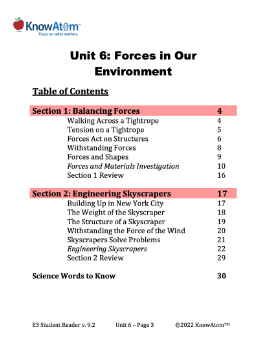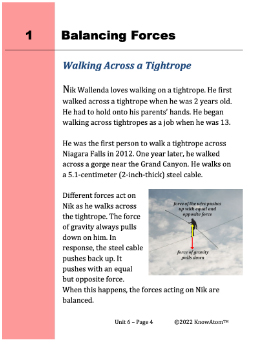Once students understand how forces act on different materials and shapes, they use that knowledge to help them design skyscrapers that resist different forces related to weight and high winds in this lesson.
In this unit, students analyze the science phenomena of different forces that can act on all structures. They begin by exploring how forces act on different materials and shapes. They then use what they know about forces to design a skyscraper prototype in this lesson, evaluating how their design relates to the ability of the skyscraper to withstand the weight of the structure and the people on it, as well as the force of wind. This page showcases components of this engineering lesson.
Science background provides teachers with more in-depth information about the phenomena students explore in this unit. Below is an excerpt from the background information on how to engineer a skyscraper.
You can see evidence of geometric shapes in the structure of many skyscrapers, which need to be carefully designed to ensure they are strong enough to withstand all of the forces acting on them. Skyscrapers are tall buildings with many stories that can contain many people in a vertical space.
Engineers have built many skyscrapers in cities around the world, including New York City, which is famous for its skyline. The skyline is the outline of land and buildings in an area against the sky. New York City has more than 100 buildings that are 183 meters (600 feet) or taller, including the tallest, One World Trade Center, which rises 541 meters (1,776 feet) into the air. Skyscrapers solve an important problem. As more people move to cities looking for jobs, there becomes less space for buildings. One solution has been to build upwards. Skyscrapers take up less land while allowing many people to work and live in them.
There are many challenges for engineers who design skyscrapers. To begin with, each floor that is added to a building pushes down on the walls and floors below it. As this weight pushes down and the ground pushes back, the structure experiences compression.
As materials compress, they can also begin to bend. This bending causes compression on one side of the material and tension on the other side. This means the skyscraper has to be very strong so it can withstand all of this weight pushing down. It also has to be able to withstand the weight of all of the people in it. Engineers use steel beams to resist these forces. Steel is a strong material that will not crack or break in response to strong compression or tension.
As materials compress, they can also begin to bend. This bending causes compression on one side of the material and tension on the other side. This means the skyscraper has to be very strong so it can withstand all of this weight pushing down. It also has to be able to withstand the weight of all of the people in it. Engineers use steel beams to resist these forces. Steel is a strong material that will not crack or break in response to strong compression or tension.
The first part of the skyscraper to be built is its foundation. The foundation is the part of the skyscraper or other building that connects it to the ground, and its purpose is to support the weight of the structure. In a regular house, the foundation is much less deep than that of a skyscraper because it has less weight pushing down. Skyscrapers weigh thousands of metric tons and rest on specially designed pilings or solid rock deep in the earth. Heavy, hollow, steel cylinders, called caissons, are driven deep into the ground, and filled with concrete to support the massive structure above.
Many modern skyscrapers also have a central core. This is the stiff “backbone” within the skyscraper. It is the central vertical beam that holds the skyscraper in place, and it is often made of concrete and steel. These materials are important because they have unique properties needed to support much of the skyscraper’s weight.
Once students understand how forces act on different materials and shapes, they use that knowledge to help them design skyscrapers that resist different forces related to weight and high winds in this lesson.

Prepared hands-on materials, full year grade-specific curriculum, and personalized live professional development designed to support mastery of current state science standards.
Misconception: If an object is at rest, there are no forces acting on it.
Fact: There are forces everywhere. When an object is at rest, all of the forces acting on it are balanced.
Misconception: A force is necessary to keep an object moving.
Fact: An unbalanced force changes an object’s motion. An object that is already in motion will continue moving until acted on by an unbalanced force, such as friction.
Misconception: Only moving objects have energy.
Fact: Nonmoving objects have stored potential energy.
Bending : when forces cause tension to happen on one side of an object or material and compression to happen on the other side
Compression : when forces push the ends of an object toward each other
Material : any kind of matter that makes up objects
Shear : when forces push one part of a structure one way and another part the opposite way
Skyscraper : a tall building with many stories that can contain many people in a vertical space
Structure : anything that is made up of parts and can support and withstand all of the forces that act on it
Tension : when forces pull the ends of an object in opposite directions
Torsion : when forces cause an object to twist
The Weight of the Skyscraper
Before engineers build a skyscraper, they have to do research. They need to know what forces will act on it. The skyscraper will have to be strong enough to withstand all of those forces.
Many challenges face engineers who design skyscrapers. First, every floor pushes down on the walls and floors below. People in a skyscraper add more weight to it. As this weight pushes down, the ground pushes back. This causes compression. As materials compress, they can also bend.
The skyscraper has to be very strong so it can withstand all of these forces. Engineers use steel beams to resist these forces. Steel is a strong material. It won’t crack or break in response to strong compression or tension.
The Structure of a Skyscraper
The first part of the skyscraper to be built is its foundation. The foundation connects skyscrapers and other buildings to the ground.
The foundation supports the weight of the structure. A skyscraper needs a deep foundation because it is so heavy. In a regular house, the foundation is less deep. This is because it has less weight pushing down.
Many skyscrapers also have a central core. This is the stiff “backbone” within the skyscraper. It is the central vertical beam that holds the skyscraper in place. The central core is often made of concrete and steel. It supports most of the skyscraper’s weight. The combination of concrete and steel don’t change their shape easily when forces act on them.



For the hands-on activity of this lesson, students apply what they know about the forces that act on structures to design and build skyscrapers that resist different forces related to weight and high winds. Students use information from a scenario to help them define the main problem facing the city of Boston, which needs engineers to design a skyscraper with five floors that resists the forces caused by high winds in the city and the weight of a school on the top floor. Students identify the criteria and constraints of the problem. Then, they create visual models of their prototype skyscraper solutions. Once they have built a prototype, they carry out a procedure for testing it to see how well it solves the problem. Students collect and analyze data on how well their skyscraper prototypes withstand weight and high winds, using their data to identify possible failure points that they can improve upon.
KnowAtom incorporates formative and summative assessments designed to make students thinking visible for deeper student-centered learning.

Standards citation: NGSS Lead States. 2013. Next Generation Science Standards: For States, By States. Washington, DC: The National Academies Press. Neither WestEd nor the lead states and partners that developed the Next Generation Science Standards were involved in the production of this product, and do not endorse it.